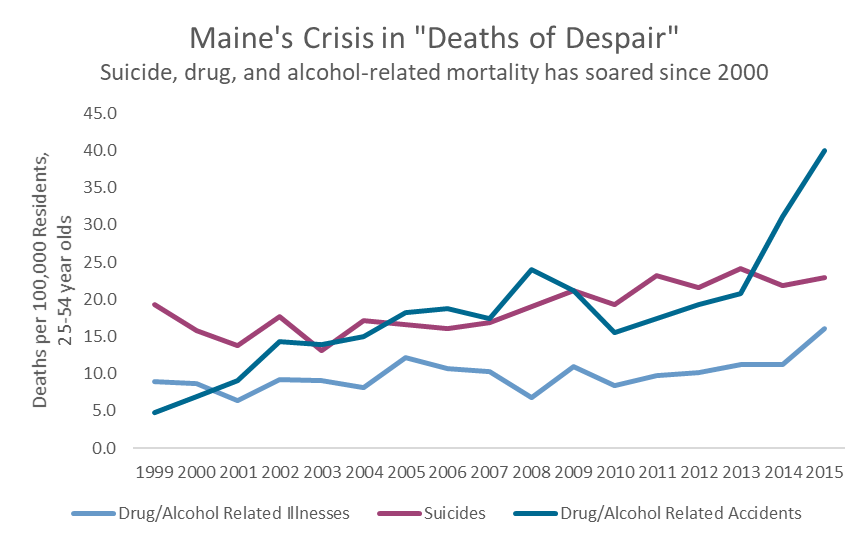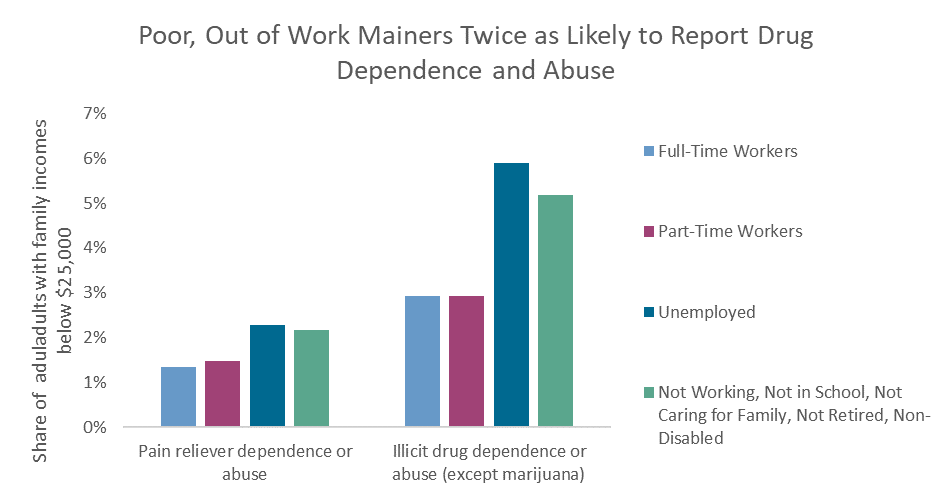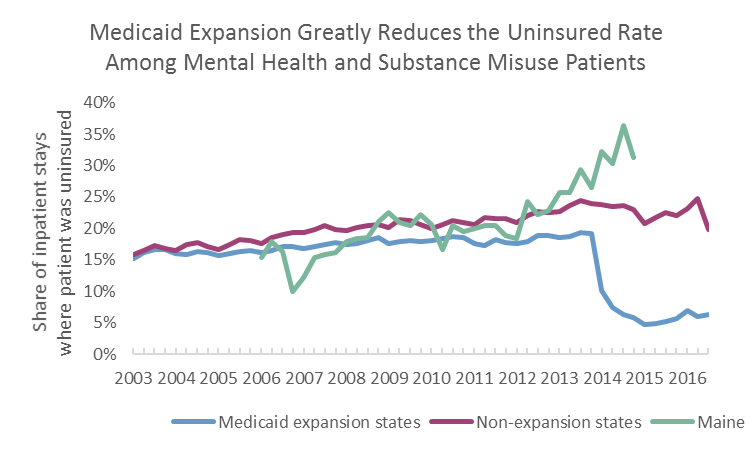Another year has come and gone with no sign that the pace of drug related deaths – more than one a day – is slowing.
On Wednesday, January 3, the Legislature’s Task Force to Address the Opioid Crisis in the State will present its final report to the Health and Human Service Committee.
The final report includes many important recommendations, ranging from de-stigmatizing the language around drug use employed by state officials to better treatment models and prevention strategies. Few of its recommendations, however, are new. Many were contained in previous reports to the Legislature.
More concerning, however, is the omission from the report of two factors critical to understanding and tackling the opioid epidemic: the role of the economy, and of basic access to health care.
Economic fragility and the drug crisis
As MECEP previously noted in its State of Working Maine 2017 report, the rising number of deaths from opioid overdoses is just one symptom of the worsening phenomenon of “deaths of despair” among white Americans without a college degree. In addition to drug-related deaths, fatalities from alcohol use and suicide have increased significantly over the past 15 years and have led to a drop in life expectancy among Americans in 2016 and 2017 for the first time in half a century. In Maine, the rate of these deaths of despair has increased even faster than the national average, rising from 30 to 80 per 100,000 residents to between 2000 and 2015.
 Source: MECEP analysis of US Centers for Disease Control and Prevention data
Source: MECEP analysis of US Centers for Disease Control and Prevention data
Because deaths of despair occur from multiple causes, drug use is likely just another symptom of the underlying problem — economic malaise. As also noted in The State of Working Maine, the entire state, but especially rural Maine, never fully recovered from the recessions of the early 2000s before the Great Recession of 2007 struck. As a result, rural Maine experienced seven years of negative GDP growth (a longer stretch than the national experience in the Great Depression of 1929), while real wages and the share of working-age Mainers employed part- or full-time statewide are below pre-recession levels.
Impoverished Mainers and those who are out of work are at the highest risk of addiction. Abuse of prescription drugs is many times higher among Mainers in poverty than those in households with income above the poverty line. Mainers without a full-time job, who aren’t in school or raising a family, are much more likely to misuse prescription drugs than those who are working. Similar statistics apply to Mainers’ risk of mental illness and likelihood to attempt suicide. All these indicators point to the role economic insecurity plays in substance abuse.

Source: MECEP analysis of National Survey on Drug Use and Health, 2015
Solving the opioid epidemic is not going to be quick or easy. Many of the underlying economic conditions — chronic poverty, lack of good-paying jobs, and the cost of higher education — are structural issues that will require sustained, bold action from lawmakers. But the Legislature already has one new tool at its disposal, thanks to Maine voters last November.
Medicaid expansion key to reversing opioid trends
The decision to expand Medicaid coverage to tens of thousands of Mainers, which comes with considerable funding from the federal government, has the potential to transform substance abuse treatment in Maine. In neighboring New Hampshire, the decision to expand Medicaid coverage is credited with the provision of coverage to 10,000 new patients in its first year alone. Nationally, states that have expanded Medicaid have seen the largest increases in provision of proven medication-assisted treatments. Incredibly, as opioid related deaths have increased exponentially in Maine, Medicaid spending on medication to treat opioid addiction has fallen, due to restrictions placed on spending for those medications and stricter eligibility rules that led to cuts in Maine’s Medicaid rolls. At a time when access to care should be expanded, Gov. Paul LePage’s administration has made it more difficult for those in need to get treatment.
The impact of these policies is showing up in hospital treatment data. Despite increasing rates of substance use, and the rising death toll, the number of inpatient treatments for drug use has barely changed over the past few years. Where more Mainers have been getting help, it’s primarily been in emergency rooms, where treatment focuses on immediate stabilization rather than long-term recovery. Hospitals and other care providers have also seen increasing numbers of uninsured patients as Medicaid coverage has been taken away from tens of thousands of Mainers in recent years.

Source: MECEP analysis of US Agency for Healthcare Research and Quality, Healthcare Cost and Utilization Project data from the State Inpatient Databases project
Maine’s recent vote to expand Medicaid coverage offers new hope for thousands to get access to treatment for substance misuse. It’s also a critical step in bolstering Maine’s flagging economy, which is itself driving Mainers to drug use. A healthy workforce is critical to a healthy economy, and a healthy economy will lead fewer Mainers to slip into despair and substance abuse.
When the HHS committee reviews the recommendations of the opioid task force Wednesday, they must remember that Maine’s voters have already delivered them one of their most effective tools in Medicaid Expansion. If the Legislature is serious about tackling the opioid crisis, they must fund and implement expansion as soon as possible.



